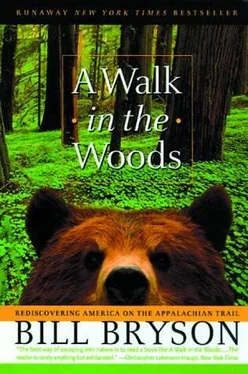Bill Bryson - A Walk In The Woods
Здесь есть возможность читать онлайн «Bill Bryson - A Walk In The Woods» весь текст электронной книги совершенно бесплатно (целиком полную версию без сокращений). В некоторых случаях можно слушать аудио, скачать через торрент в формате fb2 и присутствует краткое содержание. Жанр: Современная проза, на английском языке. Описание произведения, (предисловие) а так же отзывы посетителей доступны на портале библиотеки ЛибКат.
- Название:A Walk In The Woods
- Автор:
- Жанр:
- Год:неизвестен
- ISBN:нет данных
- Рейтинг книги:4 / 5. Голосов: 1
-
Избранное:Добавить в избранное
- Отзывы:
-
Ваша оценка:
- 80
- 1
- 2
- 3
- 4
- 5
A Walk In The Woods: краткое содержание, описание и аннотация
Предлагаем к чтению аннотацию, описание, краткое содержание или предисловие (зависит от того, что написал сам автор книги «A Walk In The Woods»). Если вы не нашли необходимую информацию о книге — напишите в комментариях, мы постараемся отыскать её.
A Walk In The Woods — читать онлайн бесплатно полную книгу (весь текст) целиком
Ниже представлен текст книги, разбитый по страницам. Система сохранения места последней прочитанной страницы, позволяет с удобством читать онлайн бесплатно книгу «A Walk In The Woods», без необходимости каждый раз заново искать на чём Вы остановились. Поставьте закладку, и сможете в любой момент перейти на страницу, на которой закончили чтение.
Интервал:
Закладка:
On top of its self-generated shortcomings, Shenandoah has a lot of problems arising from factors largely beyond its control. Overcrowding is one. Although the park is over a hundred miles long, it is almost nowhere more than a mile or two wide, so all its two million annual visitors are crowded into a singularly narrow corridor along the ridgeline. Campgrounds, visitor centers, parking lots, picnic sites, the AT, and Skyline Drive (the scenic road that runs down the spine of the park) all exist cheek by jowl. One of the most popular (non-AT) hiking routes in the park, up Old Rag Mountain, has become so much in demand that on summer weekends people sometimes have to queue to get on it.
Then there is the vexed matter of pollution. Thirty years ago it was still possible on especially clear days to see the Washington Monument, seventy-five miles away. Now, on hot, smoggy summer days, visibility can be as little as two miles and never more than thirty. Acid rain in the streams has nearly wiped out the park’s trout. Gypsy moths arrived in 1983 and have since ravaged considerable acreages of oaks and hickories. The Southern pine beetle has done similar work on conifers, and the locust leaf miner has inflicted disfiguring (but mercifully usually nonfatal) damage on thousands of locust trees. In just seven years, the woolly adelgid has fatally damaged more than 90 percent of the park’s hemlocks. Nearly all the rest will be dying by the time you read this. An untreatable fungal disease called anthracnose is wiping out the lovely dogwoods not just here but everywhere in America. Before long, the dogwood, like the American chestnut and American elm, will effectively cease to exist. It would be hard, in short, to conceive a more stressed environment.
And yet here’s the thing. Shenandoah National Park is lovely. It is possibly the most wonderful national park I have ever been in, and, considering the impossible and conflicting demands put on it, it is extremely well run. Almost at once it became my favorite part of the Appalachian Trail.
We hiked through deep-seeming woods, along gloriously untaxing terrain, climbing a gentle 500 feet in four miles. In the Smokies, you can climb 500 feet in, well, about 500 feet. This was more like it. The weather was kindly, and there was a real sense of spring being on the turn. And there was life everywhere-zumming insects, squirrels scampering along boughs, birds twittering and hopping about, spider webs gleaming silver in the sun. Twice I flushed grouse, always a terrifying experience: an instantaneous explosion from the undergrowth at your feet, like balled socks fired from a gun, followed by drifting feathers and a lingering residue of fussy, bitching noise. I saw an owl, which watched me imperturbably from a nearby stout limb, and loads of deer, which raised their heads to stare but otherwise seemed fearless and casually returned to their browsing when I had passed. Sixty years ago, there were no deer in this neck of the Blue Ridge Mountains. They had been hunted out of existence. Then, after the park was created in 1936, thirteen white-tailed deer were introduced, and, with no one to hunt them and few predators, they thrived. Today there are 5,000 deer in the park, all descended from those original thirteen or others that migrated from nearby.
Surprisingly, considering its modest dimensions and how little room there is for real backcountry, the park is remarkably rich in wildlife. Bobcats, bears, red and gray foxes, beaver, skunks, raccoons, flying squirrels, and our friends the salamanders exist in admirable numbers, though you don’t often see them, as most are nocturnal or wary of people. Shenandoah is said to have the highest density of black bears anywhere in the world-slightly over one per square mile. There have even been reported sightings (including by park rangers, who perhaps ought to know better) of mountain lions, even though mountain lions haven’t been confirmed in the eastern woods for almost seventy years. There is the tiniest chance that they may exist in pockets in the northern woods (we shall get to that in due course, and I think you’ll be glad you waited) but not in an area as small and hemmed in as Shenandoah National Park.
We didn’t see anything terribly exotic, or even remotely exotic, but it was nice just to see squirrels and deer, to feel that the forest was lived in. Late in the afternoon, I rounded a bend to find a wild turkey and her chicks crossing the trail ahead of me. The mother was regal and unflappable; her chicks were much too busy falling over and getting up again even to notice me. This was the way the woods were supposed to be. I couldn’t have been more delighted.
We hiked till five and camped beside a tranquil spring in a small, grassy clearing in the trees just off the trail. Because it was our first day back on the trail, we were flush for food, including perishables like cheese and bread that had to be eaten before they went off or were shaken to bits in our packs, so we rather gorged ourselves, then sat around smoking and chatting idly until persistent and numerous midgelike creatures (no-see-ums, as they are universally known along the trail) drove us into our tents. It was perfect sleeping weather, cool enough to need a bag but warm enough that you could sleep in your underwear, and I was looking forward to a long night’s snooze-indeed was enjoying a long night’s snooze-when, at some indeterminate dark hour, there was a sound nearby that made my eyes fly open. Normally, I slept through everything-through thunderstorms, through Katz’s snoring and noisy midnight pees-so something big enough or distinctive enough to wake me was unusual. There was a sound of undergrowth being disturbed-a click of breaking branches, a weighty pushing through low foliage-and then a kind of large, vaguely irritable snuffling noise.
Bear!
I sat bolt upright. Instantly every neuron in my brain was awake and dashing around frantically, like ants when you disturb their nest. I reached instinctively for my knife, then realized I had left it in my pack, just outside the tent. Nocturnal defense had ceased to be a concern after many successive nights of tranquil woodland repose. There was another noise, quite near.
“Stephen, you awake?” I whispered.
“Yup,” he replied in a weary but normal voice.
“What was that?”
“How the hell should I know.”
“It sounded big.”
“Everything sounds big in the woods.”
This was true. Once a skunk had come plodding through our camp and it had sounded like a stegosaurus. There was another heavy rustle and then the sound of lapping at the spring. It was having a drink, whatever it was.
I shuffled on my knees to the foot of the tent, cautiously unzipped the mesh and peered out, but it was pitch black. As quietly as I could, I brought in my backpack and with the light of a small flashlight searched through it for my knife. When I found it and opened the blade I was appalled at how wimpy it looked. It was a perfectly respectable appliance for, say, buttering pancakes, but patently inadequate for defending oneself against 400 pounds of ravenous fur.
Carefully, very carefully, I climbed from the tent and put on the flashlight, which cast a distressingly feeble beam. Something about fifteen or twenty feet away looked up at me. I couldn’t see anything at all of its shape or size-only two shining eyes. It went silent, whatever it was, and stared back at me.
“Stephen,” I whispered at his tent, “did you pack a knife?”
“No.”
“Have you get anything sharp at all?”
He thought for a moment. “Nail clippers.”
I made a despairing face. “Anything a little more vicious than that? Because, you see, there is definitely something out here.”
“It’s probably just a skunk.”
“Then it’s one big skunk. Its eyes are three feet off the ground.”
Читать дальшеИнтервал:
Закладка:
Похожие книги на «A Walk In The Woods»
Представляем Вашему вниманию похожие книги на «A Walk In The Woods» списком для выбора. Мы отобрали схожую по названию и смыслу литературу в надежде предоставить читателям больше вариантов отыскать новые, интересные, ещё непрочитанные произведения.
Обсуждение, отзывы о книге «A Walk In The Woods» и просто собственные мнения читателей. Оставьте ваши комментарии, напишите, что Вы думаете о произведении, его смысле или главных героях. Укажите что конкретно понравилось, а что нет, и почему Вы так считаете.












